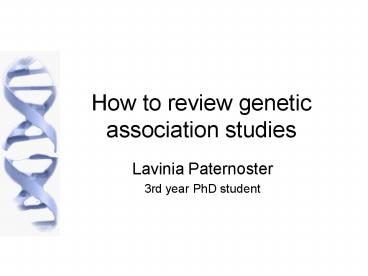How to review genetic association studies - PowerPoint PPT Presentation
1 / 28
Title:
How to review genetic association studies
Description:
(exercise) Observations (e.g. ... Exercise & Fatigue. Genetic Associations. The simplest mutation (ab) gives 3 genotypes: aa, ab, bb. Comparing 3 groups not 2 ... – PowerPoint PPT presentation
Number of Views:56
Avg rating:3.0/5.0
Title: How to review genetic association studies
1
How to review genetic association studies
- Lavinia Paternoster
- 3rd year PhD student
2
Outline
- Traditional meta-analyses
- Why are genetic studies unique?
- Methods
- choosing a genetic model
- Multiple testing
- Overall association
- Per-allele mean differences
- Other things to consider
3
Research Question
- Does having gene X increase the risk of
disease/trait Y? - Same as
- Does intervention X increase the risk of
outcome Y? - BUT.
4
Traditional meta-analysis
Intervention
Control (or intervention 2)
Input variable to be tested
Observe
Outcome 1
Outcome 2
Outcome to test success of intervention
5
Traditional meta-analysis
Intervention e.g. beta-blockers
Control (or intervention 2)
Input variable to be tested
Observe
Outcome 1 e.g. cardiovascular disease
Outcome 2 e.g. no cardiovascular disease
Outcome to test success of intervention
6
Traditional meta-analysis
Calculate relative risk (or odds ratio) for each
study Pool relative risks by using weighting
methods
7
Beta-blockers cardiovascular disease
8
Traditional meta-analysis
Intervention
Control
Variable to be tested
Observe
Mean value of those with intervention
Mean value of controls
Outcome to test success of intervention
9
Traditional meta-analysis
Intervention e.g. exercise
Control
Variable to be tested
Observe
Mean value of those with intervention e.g. mean
fatigue scale value
Mean value of controls e.g. mean fatigue scale
value
Outcome to test success of intervention
Edmonds et al. 2004. Exercise for chronic fatigue
syndrome. Cochrane
10
Traditional meta-analysis
Calculate mean difference (and 95CI) for each
study Pool mean differences by using weighting
methods
11
Exercise Fatigue
12
Genetic Associations
- The simplest mutation (a?b) gives 3 genotypes
aa, ab, bb - Comparing 3 groups not 2
- Conventional meta-analysis methods not suitable
13
Traditional meta-analysis
Intervention e.g. beta-blockers
Control (or intervention 2)
Input variable to be tested
Observe
Outcome 1 e.g. cardiovascular disease
Outcome 2 e.g. no cardiovascular disease
Outcome to test success of intervention
14
Traditional meta-analysis
Genotype AA
Input variable to be tested
Genotype AB
Genotype BB
Observe
Outcome 1 e.g. cardiovascular disease
Outcome 2 e.g. no cardiovascular disease
Outcome to test success of intervention
15
Traditional meta-analysis
Intervention
Control
Variable to be tested
Observe
Mean value of those with intervention
Mean value of controls
Outcome to test success of intervention
16
Traditional meta-analysis
AA
BB
Variable to be tested
AB
Observe
Mean value of those with genotype AA
Mean value of those with genotype AB
Mean value of those with genotype BB
Outcome to test success of intervention
17
My Research
- Meta-analysis of association between Carotid
intima-media thickness and several genes - Here Ill show MTHFR example
- CC / CT / TT
18
Data
CC
CT
TT
19
Methods in the literature
- Collapse into 2 groups
- Assume genetic model
- Dominant (ttct v cc)
- Recessive (tt v ctcc)
- Multiple pairwise comparisons
- tt v cc, tt v ct, ct v cc
- dominant and recessive
20
Methods in the literature
- Analyse as 3 groups
- Analyse as co-dominant (per-allele difference)
- Meta-ANOVA
21
My Method
- 3 stage approach
- Meta-ANOVA
- Looks for overall association between gene and
trait but does not indicate which alleles
increase/decrease - Determine genetic model use linear regression
- Estimate mean differences using chosen genetic
model
22
Meta- ANOVA
P0.026
Analyse by carrying out ANOVA using genotype
and study as categorical variables and
weighting each observation Test whether
genotype is a significant variable
23
Which genetic model?
- Recessive
- TT shows effect, CT CC
- MD1 0, so ?0
- Dominant
- TT CT and both show effect
- MD1 MD2, so ?1
- Co-dominant
- CT will be half way between CC and TT
- MD1/MD2 0.5
? MD1/MD2 MD1 CT CC MD2 TT - CC
Can use a linear regression of MD1 against MD2,
weighted by study to determine overall the most
appropriate genetic model
24
0.2 (95CI, 0 to 0.4) ? 0, so recessive
25
Mean differences
- For dominant and recessive genetic models combine
2 genotypes and use methods previously described - Recessive
- combine CT and CC, compare with TT
- Dominant
- Combine TT and CT, compare with CC
- For co-dominant models use per-allele difference
- Assumes same difference between TT CT, and CT
CC
26
Mean differences
- MTHFR was associated when analysed by meta-ANOVA
(p 0.026) - MTHFR was recessive (? 0.2)
- Mean difference between TT and CT/CC is 20µm
(95CI 10 to 30)
27
Summary
- Genetic association studies have at least 3
groups - Chose a model based on previous evidence
- Multiple comparisons
- Overall association
- Novel 3 stage approach
28
Other issues
- Other genetic models?
- Different polymorphisms within gene
- LD between genes?
- Whole genome meta-analysis

